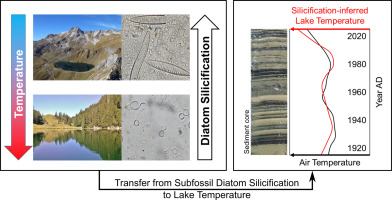当前位置:
X-MOL 学术
›
Sci. Total Environ.
›
论文详情
Our official English website, www.x-mol.net, welcomes your feedback! (Note: you will need to create a separate account there.)
Evaluating climate change impacts on mountain lakes by applying the new silicification value to paleolimnological samples.
Science of the Total Environment ( IF 9.8 ) Pub Date : 2020-01-25 , DOI: 10.1016/j.scitotenv.2020.136913 Wolfgang Kuefner 1 , Andrea M Hofmann 1 , Juergen Geist 2 , Uta Raeder 1
Science of the Total Environment ( IF 9.8 ) Pub Date : 2020-01-25 , DOI: 10.1016/j.scitotenv.2020.136913 Wolfgang Kuefner 1 , Andrea M Hofmann 1 , Juergen Geist 2 , Uta Raeder 1
Affiliation

|
The evaluation of climate change impact on lakes typically relies on statistical methods like the reorganisation of organism communities (beta diversity) or transfer functions. A new method uses the silicification of diatoms that correlates with temperature and nutrients. The so-called silicification value (SiVa) overcomes problems of descriptive statistics or absent indicator species. Averaged over diatom communities, it related inversely to lake surface temperatures in mountain lakes. Hence, its change over time (δ SiVa) in a lake was hypothesised to reflect global change-driven lake warming quantitatively, which supposedly climaxes in shallow lakes. Sixteen different δ SiVa calculation approaches were tested. They (1) included or excluded planktic diatoms, (2) integrated fixed or variable time series referring to climate data or changes in diatom assemblages, (3) employed a top-bottom or regression approach and (4) expressed the δ SiVa as relative or absolute values. Subfossil diatom assemblages from 24 sediment cores from Bavarian and north Tyrolian mountain lakes served as sample set. All possible approaches were evaluated for their explanatory power for lake characteristics using GLMs. The top-bottom benthic approach with fixed climate data-based time series appeared to be the best model based on AIC and the extent of variable integration. In line with the hypothesis, the strongest decrease of δ SiVa was evident in most shallow lakes. Segmented regression further highlighted a positive correlation with depth if shallower than 10 m. By referring to the negative SiVa-summer temperature relation, δ SiVa also enabled the quantification of lake warming within the last decades, which ranged mainly between 0.1 °C and 1.1 °C per decade, consistent with existing literature. Additionally, a 100 year temperature reconstruction from a varved sediment core successfully validated the approach. Further studies may focus and extend its application to deeper lakes, but it can already serve as a powerful tool in palaeolimnological studies of shallow lakes like hard-water mountain lakes.
中文翻译:

通过将新的硅化值应用于古湖泊样品,评估气候变化对高山湖泊的影响。
评估气候变化对湖泊的影响通常依赖于统计方法,例如生物群落的重组(β多样性)或转移函数。一种新方法使用了与温度和营养成分相关的硅藻硅化作用。所谓的硅化值(SiVa)克服了描述性统计数据或缺少指标种类的问题。在硅藻群落上平均,它与高山湖泊的湖面温度成反比。因此,假设其随时间的变化(δSiVa)可以定量地反映全球变化驱动的湖泊变暖,据推测这是浅湖的高潮。测试了16种不同的δSiVa计算方法。他们(1)包括或排除了板状硅藻,(2)结合气候数据或硅藻集合体的变化的固定或可变时间序列,(3)采用上下或回归方法,(4)将δSiVa表示为相对或绝对值。来自巴伐利亚和北蒂罗尔山地湖的24个沉积岩心的亚化石硅藻组合体作为样本集。使用GLM评估了所有可能的方法对湖泊特征的解释力。基于固定气候数据时间序列的底栖底栖方法似乎是基于AIC和变量整合程度的最佳模型。与该假设一致,在大多数浅水湖泊中,δSiVa下降最明显。如果小于10 m,分段回归进一步强调与深度呈正相关。通过参考负的SiVa-夏季温度关系,δSiVa还可以量化过去几十年内湖泊变暖的幅度,与现有文献一致,该幅度主要在每十年0.1°C至1.1°C之间。此外,从裂谷沉积岩心进行的100年温度重建成功地验证了该方法。进一步的研究可能会将其应用集中并扩展到更深的湖泊,但是它已经可以作为浅水湖泊(如硬水山区湖泊)的古湖泊学研究的有力工具。
更新日期:2020-01-26
中文翻译:

通过将新的硅化值应用于古湖泊样品,评估气候变化对高山湖泊的影响。
评估气候变化对湖泊的影响通常依赖于统计方法,例如生物群落的重组(β多样性)或转移函数。一种新方法使用了与温度和营养成分相关的硅藻硅化作用。所谓的硅化值(SiVa)克服了描述性统计数据或缺少指标种类的问题。在硅藻群落上平均,它与高山湖泊的湖面温度成反比。因此,假设其随时间的变化(δSiVa)可以定量地反映全球变化驱动的湖泊变暖,据推测这是浅湖的高潮。测试了16种不同的δSiVa计算方法。他们(1)包括或排除了板状硅藻,(2)结合气候数据或硅藻集合体的变化的固定或可变时间序列,(3)采用上下或回归方法,(4)将δSiVa表示为相对或绝对值。来自巴伐利亚和北蒂罗尔山地湖的24个沉积岩心的亚化石硅藻组合体作为样本集。使用GLM评估了所有可能的方法对湖泊特征的解释力。基于固定气候数据时间序列的底栖底栖方法似乎是基于AIC和变量整合程度的最佳模型。与该假设一致,在大多数浅水湖泊中,δSiVa下降最明显。如果小于10 m,分段回归进一步强调与深度呈正相关。通过参考负的SiVa-夏季温度关系,δSiVa还可以量化过去几十年内湖泊变暖的幅度,与现有文献一致,该幅度主要在每十年0.1°C至1.1°C之间。此外,从裂谷沉积岩心进行的100年温度重建成功地验证了该方法。进一步的研究可能会将其应用集中并扩展到更深的湖泊,但是它已经可以作为浅水湖泊(如硬水山区湖泊)的古湖泊学研究的有力工具。


























 京公网安备 11010802027423号
京公网安备 11010802027423号